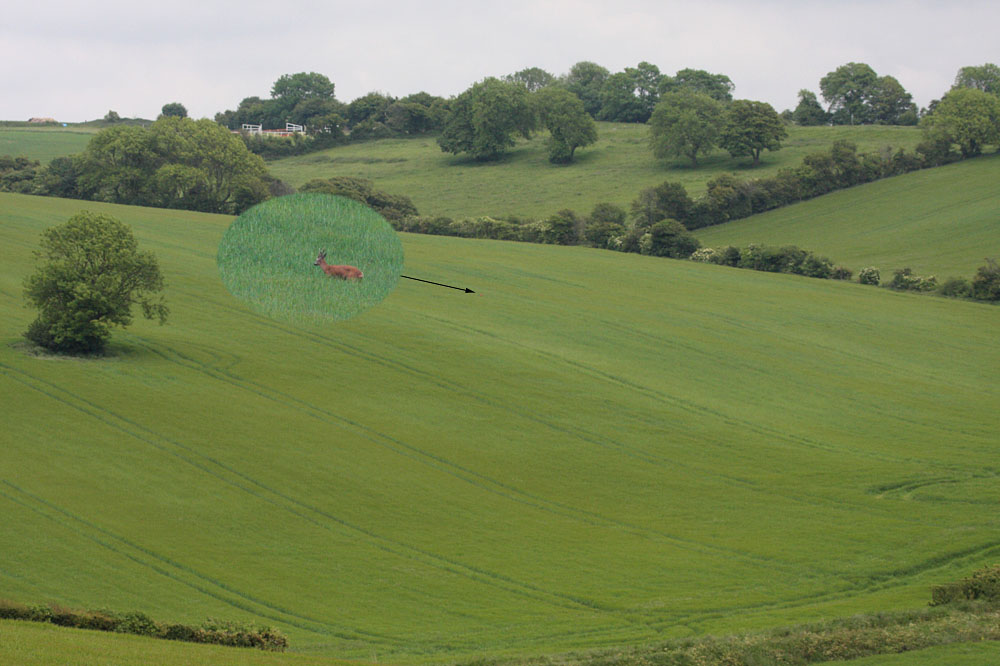Recently I've become much more adept at spotting wildlife at a distance. There's the example of the fox on Sunday. It's not that I have great eyesight, but I have got much better at seeing small anomalies in the landscape, either a movement or a hint of colour. It's something to do with pattern recognition, noticing difference without needing to see precisely what it is you're looking at.
Here's an example from today. I was looking out over the empty fields when I thought, hang on a moment there's something over there. I took a number of shots on full zoom (400mm, which with the 1.6x crop factor of the camera sensor gives a 35mm film equivalent of 640mm, or 12-13x magnification). I also took a shot at 100mm length (which is about 3x magnification). This is the result. The main image is the 100mm shot, and the arrow points to the anomaly. The inset is cropped from a 400mm shot.
 Roe deer buck – click to enlarge
Roe deer buck – click to enlarge
Of course I do sometimes get a little closer to my subjects. This is from tonight. It's a full frame shot (not cropped, just reduced in size) of the bold vixen. It was taken with the 105mm macro lens from a couple of feet away.
Which goes some way to explaining why so many lenses are needed. I couldn't have photographed or even identified the deer with the macro lens; and I was far too close to the fox to have been able to focus with the long lens.
Camera note: the deer was photographed with the EF 100-400mm f/4.5-5.6L USM IS lens. The fox was photographed with the Sigma 105mm F2.8 EX DG macro lens.

RobinL
10 Jun 2009Great shots. Love the close up of the fox. She's a real beauty. The inset of the deer is really good. Amazing what that long lens will do!
gdare
10 Jun 2009This is really tiny spot you noticed :eyes: And close up of the fox looks like she was standing right in front of your lens 😛
cakkleberrylane
10 Jun 2009You are very good! My eyes are terrible. Recently I spent 10 minutes quietly sneaking up on a plastic bag. My son-in-law calls the shot, "The rare and elusive bag bird".
SittingFox
10 Jun 2009@Lois – 😆
Absolutely wonderful portrait picture! :yes:
Unfortunately, shooting at ridiculously long range is getting to be the norm for me 🙁 I keep eyeing up the 100-400 EF Canon lens in the local shop, but (apart from the fact that I cannot afford it!) I'm actually not convinced that 400mm would be long enough for me.
Words
10 Jun 2009Thanks Robin! It was impossible to see what was in the field until I'd taken the shot and looked on the camera screen.
Words
10 Jun 2009Darko, yes it really as a tiny spot. I 'lost' it a couple of times while I was looking. And the fox was two or three feet away, as you right in front of the camera. 😀
Words
10 Jun 2009Adele, I'm sure your right about needing more reach. With your Tamron you've already got 500mm plus the flexibility of a zoom. If you do go for Canon I would look at the primes plus a converter. And wait for exchange rates to readjust. Prices are nuts at the moment.
Words
10 Jun 2009Lois, we've done the plastic bag thing here as well. Easily done 😆
SittingFox
10 Jun 2009Canon prime lenses…it would be nice not to have to use a converter, but I'll either have to have multiple promotions at work or write a bestseller or something 😉 But seeing your photos, and things like this does reinforce my general perception that Canon white lenses must be very nice things to have! :whistle:
Words
10 Jun 2009They're great lenses, and Robin's woodpecker is a great advert for them. As are these red squirrels by Kev Lewis.
chthoniid
11 Jun 2009He, he- you always need more lenses Words 🙂
It actually starts to get tricky focusing with lenses that ahave a FL over 400mm. The angle of view narrows significantly and the motion of the photographer (via the camera and lens) gets exagerrated. Tripods and blinds start becoming vital.
Fwiw, a lot of the wildlife film photographers of the film-era only used a (sharp) 300mm prime.
I stick to a 300mm prime with a 1.4x TC for most of my work- as it's a good compromise between protability and reach.
Words
11 Jun 2009Brendan, not only tricky focusing lenses over 400mm, but near impossible to finance them. I see a lot of photos taken on 300mm primes + teleconverters. It's clearly a good combination and one of the options I considered before I went for the 400mm prime.
Ukwildlife
16 Jun 2009Great stuff. Well I say that but your suggesting I have to spend a few £100s more on a macro lens now…..oh well if you insist 😉 😀
Words
16 Jun 2009Neil, the deer was certainly at the extreme end of things. If you really want to get close to things you'll need to try this.